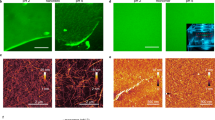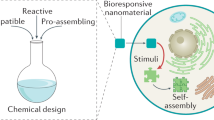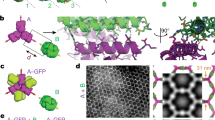Abstract
There is broad interest in designing nanostructured materials that can interact with cells and regulate key downstream functions1,2,3,4,5,6,7. In particular, materials with nanoscale features may enable control over multivalent interactions, which involve the simultaneous binding of multiple ligands on one entity to multiple receptors on another and are ubiquitous throughout biology8,9,10. Cellular signal transduction of growth factor and morphogen cues (which have critical roles in regulating cell function and fate) often begins with such multivalent binding of ligands, either secreted or cell-surface-tethered to target cell receptors, leading to receptor clustering11,12,13,14,15,16,17,18. Cellular mechanisms that orchestrate ligand–receptor oligomerization are complex, however, so the capacity to control multivalent interactions and thereby modulate key signalling events within living systems is currently very limited. Here, we demonstrate the design of potent multivalent conjugates that can organize stem cell receptors into nanoscale clusters and control stem cell behaviour in vitro and in vivo. The ectodomain of ephrin-B2, normally an integral membrane protein ligand, was conjugated to a soluble biopolymer to yield multivalent nanoscale conjugates that potently induce signalling in neural stem cells and promote their neuronal differentiation both in culture and within the brain. Super-resolution microscopy analysis yielded insights into the organization of the receptor–ligand clusters at the nanoscale. We also found that synthetic multivalent conjugates of ephrin-B1 strongly enhance human embryonic and induced pluripotent stem cell differentiation into functional dopaminergic neurons. Multivalent bioconjugates are therefore powerful tools and potential nanoscale therapeutics for controlling the behaviour of target stem cells in vitro and in vivo.
This is a preview of subscription content, access via your institution
Access options
Subscribe to this journal
Receive 12 print issues and online access
$259.00 per year
only $21.58 per issue
Buy this article
- Purchase on Springer Link
- Instant access to full article PDF
Prices may be subject to local taxes which are calculated during checkout





Similar content being viewed by others
References
Jiang, W., Kim, B. Y., Rutka, J. T. & Chan, W. C. Nanoparticle-mediated cellular response is size-dependent. Nature Nanotech. 3, 145–150 (2008).
Mannix, R. J. et al. Nanomagnetic actuation of receptor-mediated signal transduction. Nature Nanotech. 3, 36–40 (2008).
McMurray, R. J. et al. Nanoscale surfaces for the long-term maintenance of mesenchymal stem cell phenotype and multipotency. Nature Mater. 10, 637–644 (2011).
Ng, Q. K. et al. Engineering clustered ligand binding into nonviral vectors: αvβ3 targeting as an example. Mol. Ther. 17, 828–836 (2009).
Maheshwari, G., Brown, G., Lauffenburger, D. A., Wells, A. & Griffith, L. G. Cell adhesion and motility depend on nanoscale RGD clustering. J. Cell Sci. 113, 1677–1686 (2000).
Lee, L. A. et al. Multivalent ligand displayed on plant virus induces rapid onset of bone differentiation. Mol. Pharmacol. 9, 2121–2125 (2012).
Petrie, T. A. et al. Multivalent integrin-specific ligands enhance tissue healing and biomaterial integration. Sci. Transl. Med. 2, 45ra60 (2010).
Mammen, M., Choi S-K. & Whitesides, G. M. Polyvalent interactions in biological systems: implications for design and use of multivalent ligands and inhibitors. Angew. Chem. Int. Ed. 37, 2754–2794 (1998).
Kiessling, L. L., Gestwicki, J. E. & Strong, L. E. Synthetic multivalent ligands in the exploration of cell-surface interactions. Curr. Opin. Chem. Biol. 4, 696–703 (2000).
Vance, D., Shah, M., Joshi, A. & Kane, R. S. Polyvalency: a promising strategy for drug design. Biotechnol. Bioeng. 101, 429–434 (2008).
Artavanis-Tsakonas, S., Rand, M. D. & Lake, R. J. Notch signaling: cell fate control and signal integration in development. Science 284, 770–776 (1999).
Broudy, V. C., Lin, N. L., Buhring, H. J., Komatsu, N. & Kavanagh, T. J. Analysis of c-kit receptor dimerization by fluorescence resonance energy transfer. Blood 91, 898–906 (1998).
Holler, N. et al. Two adjacent trimeric Fas ligands are required for Fas signaling and formation of a death-inducing signaling complex. Mol. Cell. Biol. 23, 1428–1440 (2003).
Barleon, B. et al. Mapping of the sites for ligand binding and receptor dimerization at the extracellular domain of the vascular endothelial growth factor receptor FLT-1. J. Biol. Chem. 272, 10382–10388 (1997).
Ye, S. et al. Structural basis for interaction of FGF-1, FGF-2, and FGF-7 with different heparan sulfate motifs. Biochemistry 40, 14429–14439 (2001).
Haudenschild, D. R. et al. Enhanced activity of TGF-β1 bound to cartilage oligomeric matrix protein. J. Biol. Chem. 286, 43250–43258 (2011).
Chang, S. C., Mulloy, B., Magee, A. I. & Couchman, J. R. Two distinct sites in sonic hedgehog combine for heparan sulfate interactions and cell signaling functions. J. Biol. Chem. 286, 44391–44402 (2011).
Krilleke, D., Ng, Y. S. & Shima, D. T. The heparin-binding domain confers diverse functions of VEGF-A in development and disease: a structure–function study. Biochem. Soc. Trans. 37, 1201–1206 (2009).
Ashton, R. S. et al. Astrocytes regulate adult hippocampal neurogenesis through ephrin-B signaling. Nature Neurosci. 15, 1399–1406 (2012).
Vazin, T. et al. A novel combination of factors, termed SPIE, which promotes dopaminergic neuron differentiation from human embryonic stem cells. PLoS ONE 4, e6606 (2009).
Wall, S. T. et al. Multivalency of Sonic hedgehog conjugated to linear polymer chains modulates protein potency. Bioconj. Chem. 19, 806–812 (2008).
Pollock, J. F., Ashton, R. S., Rode, N. A., Schaffer, D. V. & Healy, K. E. Molecular characterization of multivalent bioconjugates by size-exclusion chromatography with multiangle laser light scattering. Bioconj. Chem. 23, 1794–1801 (2012).
Gurskaya, N. G. et al. Engineering of a monomeric green-to-red photoactivatable fluorescent protein induced by blue light. Nature Biotechnol. 24, 461–465 (2006).
Betzig, E. et al. Imaging intracellular fluorescent proteins at nanometer resolution. Science 313, 1642–1645 (2006).
Van de Linde, S. et al. Direct stochastic optical reconstruction microscopy with standard fluorescent probes. Nature Protoc. 6, 991–1009 (2011).
Pasquale, E. B. Eph receptor signalling casts a wide net on cell behaviour. Nature Rev. Mol. Cell Biol. 6, 462–475 (2005).
Kane, R. S. Thermodynamics of multivalent interactions: influence of the linker. Langmuir 26, 8636–8640 (2010).
Lindvall, O. Dopaminergic neurons for Parkinson's therapy. Nature Biotechnol. 30, 56–58 (2012).
Politis, M. et al. Serotonergic neurons mediate dyskinesia side effects in Parkinson's patients with neural transplants. Sci. Transl. Med. 2, 38ra46 (2010).
Lai, K., Kaspar, B. K., Gage, F. H. & Schaffer, D. V. Sonic hedgehog regulates adult neural progenitor proliferation in vitro and in vivo. Nature Neurosci. 6, 21–27 (2003).
Kempermann, G., Kuhn, H. G. & Gage, F. H. More hippocampal neurons in adult mice living in an enriched environment. Nature 386, 493–495 (1997).
Zawadzki, R. J. et al. Adaptive-optics optical coherence tomography for high-resolution and high-speed 3D retinal in vivo imaging. Opt. Express 13, 8532–8546 (2005).
Tokunaga, M., Imamoto, N. & Sakata-Sogawa, K. Highly inclined thin illumination enables clear single-molecule imaging in cells. Nature Methods 5, 159–161 (2008).
Acknowledgements
The authors thank A. Ciesielska (Bankiewicz Lab, UCSF) for help with HPLC analysis of dopamine and J. Martin (RPI) for suggestions regarding the synthesis of multivalent ligands based on monovalent hyaluronic acid scaffolds. This work was supported by the National Institutes of Health (NIH R21 EB007295) and the California Institute for Regenerative Medicine (CIRM) (grant RT2-02022). A.C. and T.V. were partially supported by training grant fellowships from CIRM (T1-00007). D.P.S. was partially supported by a National Science Foundation Graduate Research Fellowship and a training grant fellowship from CIRM (TG2-01164).
Author information
Authors and Affiliations
Contributions
A.C. performed all the experiments and analysed all data. A.C. and D.V.S. designed the ephrin-B2 experiments and wrote the manuscript. T.V., A.C. and D.V.S. designed the ephrin-B1 experiments. D.P.S. cloned the EphB4-Dendra2 retroviral vector. N.R. conducted the SEC-MALS experiment. K.E.H. and R.S.K. provided critical feedback on the manuscript.
Corresponding author
Ethics declarations
Competing interests
K.E.H. is an inventor of intellectual property related to HA bioconjugates. T.V. is an inventor of intellectual property related to dopaminergic differentiation of hESCs using SPIE.
Supplementary information
Supplementary information
Supplementary Information (PDF 809 kb)
Rights and permissions
About this article
Cite this article
Conway, A., Vazin, T., Spelke, D. et al. Multivalent ligands control stem cell behaviour in vitro and in vivo. Nature Nanotech 8, 831–838 (2013). https://doi.org/10.1038/nnano.2013.205
Received:
Accepted:
Published:
Issue Date:
DOI: https://doi.org/10.1038/nnano.2013.205
This article is cited by
-
Serum levels of FAK and some of its effectors in adult AML: correlation with prognostic factors and survival
Molecular and Cellular Biochemistry (2021)
-
Essential roles of EphrinB2 in mammalian heart: from development to diseases
Cell Communication and Signaling (2019)
-
Using enhanced number and brightness to measure protein oligomerization dynamics in live cells
Nature Protocols (2019)
-
Dual-function injectable angiogenic biomaterial for the repair of brain tissue following stroke
Nature Materials (2018)
-
Gold nanoparticles cause size-dependent inhibition of embryonic development during murine pregnancy
Nano Research (2018)



